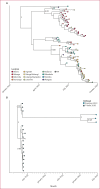2020 Ebola virus disease outbreak in Équateur Province, Democratic Republic of the Congo: a retrospective genomic characterisation
- PMID: 38278165
- PMCID: PMC10849974
- DOI: 10.1016/S2666-5247(23)00259-8
2020 Ebola virus disease outbreak in Équateur Province, Democratic Republic of the Congo: a retrospective genomic characterisation
Abstract
Background: The Democratic Republic of the Congo has had 15 Ebola virus disease (EVD) outbreaks, from 1976 to 2023. On June 1, 2020, the Democratic Republic of the Congo declared an outbreak of EVD in the western Équateur Province (11th outbreak), proximal to the 2018 Tumba and Bikoro outbreak and concurrent with an outbreak in the eastern Nord Kivu Province. In this Article, we assessed whether the 11th outbreak was genetically related to previous or concurrent EVD outbreaks and connected available epidemiological and genetic data to identify sources of possible zoonotic spillover, uncover additional unreported cases of nosocomial transmission, and provide a deeper investigation into the 11th outbreak.
Methods: We analysed epidemiological factors from the 11th EVD outbreak to identify patient characteristics, epidemiological links, and transmission modes to explore virus spread through space, time, and age groups in the Équateur Province, Democratic Republic of the Congo. Trained field investigators and health professionals recorded data on suspected, probable, and confirmed cases, including demographic characteristics, possible exposures, symptom onset and signs and symptoms, and potentially exposed contacts. We used blood samples from individuals who were live suspected cases and oral swabs from individuals who were deceased to diagnose EVD. We applied whole-genome sequencing of 87 available Ebola virus genomes (from 130 individuals with EVD between May 19 and Sept 16, 2020), phylogenetic divergence versus time, and Bayesian reconstruction of phylogenetic trees to calculate viral substitution rates and study viral evolution. We linked the available epidemiological and genetic datasets to conduct a genomic and epidemiological study of the 11th EVD outbreak.
Findings: Between May 19 and Sept 16, 2020, 130 EVD (119 confirmed and 11 probable) cases were reported across 13 Équateur Province health zones. The individual identified as the index case reported frequent consumption of bat meat, suggesting the outbreak started due to zoonotic spillover. Sequencing revealed two circulating Ebola virus variants associated with this outbreak-a Mbandaka variant associated with the majority (97%) of cases and a Tumba-like variant with similarity to the ninth EVD outbreak in 2018. The Tumba-like variant exhibited a reduced substitution rate, suggesting transmission from a previous survivor of EVD.
Interpretation: Integrating genetic and epidemiological data allowed for investigative fact-checking and verified patient-reported sources of possible zoonotic spillover. These results demonstrate that rapid genetic sequencing combined with epidemiological data can inform responders of the mechanisms of viral spread, uncover novel transmission modes, and provide a deeper understanding of the outbreak, which is ultimately needed for infection prevention and control during outbreaks.
Funding: WHO and US Centers for Disease Control and Prevention.
Published by Elsevier Ltd.
Conflict of interest statement
Declaration of interests We declare no competing interests.
Figures






References
-
- WHO Ebola: Équateur, Democratic Republic of the Congo, June–November 2020. https://www.who.int/emergencies/situations/ebola-health-update---%C3%A9q...
-
- Mbala-Kingebeni P, Pratt CB, Wiley MR, et al. 2018 Ebola virus disease outbreak in Équateur Province, Democratic Republic of the Congo: a retrospective genomic characterisation. Lancet Infect Dis. 2019;19:641–647. - PubMed
-
- Centers for Disease Control and Prevention Ebola (Ebola virus disease): outbreaks. 2022. https://www.cdc.gov/vhf/ebola/outbreaks/index-2018.html
Publication types
MeSH terms
Grants and funding
LinkOut - more resources
Full Text Sources
Medical

